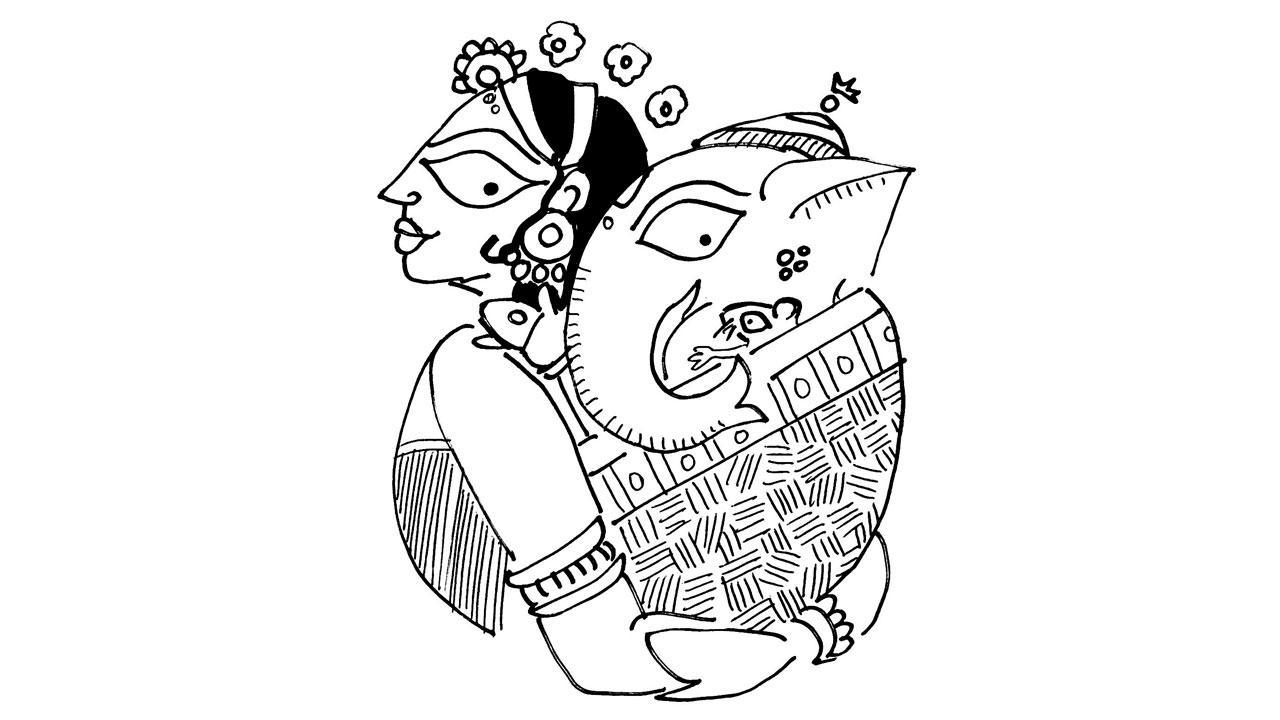This violence of the battlefield, that provides protection, is not disconnected from the violence in the kitchen, that provides nourishment.

Illustration/Devdutt Pattanaik
Key Highlights
- She is a warrior-bride, protector and provider.
- The act of turning raw food into edible food is a violent one
- In nature, life feeds on life, the eater becomes the eaten
 Ganesha’s arrival, in the latter half of the monsoon, marks the transformation of Shiva, the hermit, into Shankara, the householder. During this time, his mother is worshipped as Gauri, the homemaker. But a few weeks later, she is worshipped as Durga for nine nights. She appears as a 10-armed goddess riding a lion or a tiger, battling a wild buffalo. She is dressed as a bride with bangles, necklaces, nose ring, earrings. But she is also a warrior, with weapons. She is a warrior-bride, protector and provider. Her name evokes the safety of the citadel (durg).
Ganesha’s arrival, in the latter half of the monsoon, marks the transformation of Shiva, the hermit, into Shankara, the householder. During this time, his mother is worshipped as Gauri, the homemaker. But a few weeks later, she is worshipped as Durga for nine nights. She appears as a 10-armed goddess riding a lion or a tiger, battling a wild buffalo. She is dressed as a bride with bangles, necklaces, nose ring, earrings. But she is also a warrior, with weapons. She is a warrior-bride, protector and provider. Her name evokes the safety of the citadel (durg).
ADVERTISEMENT
This violence of the battlefield, that provides protection, is not disconnected from the violence in the kitchen, that provides nourishment. The act of turning raw food into edible food is a violent one. You have to peel, pound, chop, crush, knead, roast, steam, boil, fry the ingredients. Only then do we get food. Even before food reaches the kitchen there is violence—the cutting of trees, the uprooting of grass, the pruning of plants, the ploughing of fields, the threshing of grain, the grinding of cereals, the slaughter of pests, the castration of male animals, the culling of sick ones. And so, through the goddess we are told how violence is integral to nourishment.
In nature, life feeds on life, the eater becomes the eaten. Herbivorous animals eat plants, carnivorous animals eat animals. One living creature feeds on the other. The self can survive only by consuming the other. This becomes a metaphysical idea in the relationship of Parvati and Shiva. In a relationship, who is the feeder, who is fed, who is the food? In a yagna, the one who feeds first is the yajaman; the one who reciprocates is the devata. Who is the yajaman in marriage, who is the devata?
The patriarch says the man is the yajaman, who puts the devata in debt and obliges him to reciprocate. The householder says that both man and woman take turns, as yajaman, feeding each other, ensuring the other is free of debt. As the Yajur Veda says: Dehi ma, dadami te (give me as I give you). Thus, the household is presented not as a bondage, but as the tool of liberation. Gauri is well aware that Shankara, the householder, is Shiva, the hermit. And Shankara is aware that Gauri, the homemaker, is Kali, the wild forest. The Goddess is Vana Chandi of the forest, Rana Chandi of the battlefield, and Managala Chandi of the home.
Through marriage, we are being told that the self exists for the other, the other exists for the self. I feed you and you feed me. That is why Parvati draws Shiva from the isolation of Kailash to the crowded streets of Kashi. Here she cooks the food, she serves him the food. He is Mahadev, he is not hungry, but he collects the food in the form of bhiksha and distributes it to everyone around him. Engagement happens. The goddess here becomes the teacher, the goddess here is also the nourisher, the goddess here is also the protector. The result of such mutuality and reciprocity is Ganesha.
The author writes and lectures on the relevance of mythology in modern times. Reach him at devdutt.pattanaik@mid-day.com
 Subscribe today by clicking the link and stay updated with the latest news!" Click here!
Subscribe today by clicking the link and stay updated with the latest news!" Click here!







